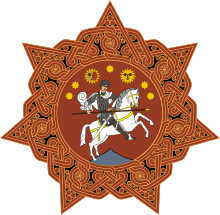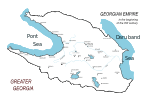Democratic Republic of Georgia
| Democratic Republic of Georgia | ||||||||||||
| საქართველოს დემოკრატიული რესპუბლიკა | ||||||||||||
| ||||||||||||
| ||||||||||||
| Anthem Dideba Zetsit Kurtheuls Praise Be To The Heavenly Bestower of Blessings | ||||||||||||
 | ||||||||||||
| Capital | Tbilisi | |||||||||||
| Languages | Georgian | |||||||||||
| Religion | Georgian Orthodox | |||||||||||
| Government | Republic | |||||||||||
| Chairman | ||||||||||||
| • | 1918 | Noe Ramishvili | ||||||||||
| • | 1918–1921 | Noe Zhordania | ||||||||||
| Historical era | Interwar period | |||||||||||
| • | Established | May 26, 1918 | ||||||||||
| • | Soviet invasion | 11 February 1921 | ||||||||||
| • | Soviet annexation | 25 February 1921 | ||||||||||
| Area | ||||||||||||
| • | 1919 | 107,600 km² (41,545 sq mi) | ||||||||||
| Population | ||||||||||||
| • | 1919 est. | 2,500,000 | ||||||||||
| Density | 23.2 /km² (60.2 /sq mi) | |||||||||||
| Currency | Georgian maneti | |||||||||||
| ||||||||||||
| Today part of | | |||||||||||
| History of Georgia |
|---|
 |
|
History by topic |
|
|
The Democratic Republic of Georgia (DRG; Georgian: საქართველოს დემოკრატიული რესპუბლიკა Sakartvelos Demokratiuli Respublika) existed from May 1918 to February 1921 and was the first modern establishment of a Republic of Georgia.
The DRG was created after the collapse of the Russian Empire that began with the Russian Revolution of 1917. Its established borders were with the Kuban People's Republic and the Mountainous Republic of the Northern Caucasus in the north, the Ottoman Empire and the First Republic of Armenia in the south, and the Azerbaijan Democratic Republic in the southeast. It had a total land area of roughly 107,600 km² (by comparison, the total area of today's Georgia is 69,700 km²), and a population of 2.5 million.
The republic's capital was Tbilisi, and its state language was Georgian. Proclaimed on May 26, 1918, on the break-up of the Transcaucasian Federation, it was led by the Georgian Social Democratic Party (Menshevik). Facing permanent internal and external problems, the young state was unable to withstand invasion by the Russian SFSR Red Armies, and collapsed between February and March 1921 to become a Soviet republic.
Background
_Chkheidze_(1864-1926)%2C_Georgian_Menshevik_politician_(small).jpg)
After the February Revolution of 1917 and collapse of the tsarist administration in the Caucasus, most power was held by the Special Transcaucasian Committee (Ozakom, short for Osobyi Zakavkazskii Komitet) of the Russian Provisional Government. All of the soviets in Georgia were firmly controlled by the Georgian Social Democratic Party, who followed the lead of the Petrograd Soviet and supported the Provisional Government. The Bolshevist October Revolution changed the situation drastically. The Caucasian soviets refused to recognize Vladimir Lenin's regime. Threats from the increasingly Bolshevistic deserting soldiers of the former Caucasus army, ethnic clashes and anarchy in the region forced Georgian, Armenian and Azerbaijani politicians to create a unified regional authority known as the Transcaucasian Commissariat (November 14, 1917) and later a legislature, the Sejm (January 23, 1918). On April 22, 1918, the Sejm - Nikolay Chkheidze[1] was the president - declared the Transcaucasus an independent democratic federation with an executive Transcaucasian government chaired by Evgeni Gegechkori[2] and later by Akaki Chkhenkeli.[3]
Many Georgians, influenced by the ideas of Ilia Chavchavadze and other intellectuals from the late 19th century, insisted on national independence. A cultural national awakening was further strengthened by the restoration of the autocephaly of the Georgian Orthodox Church (12 March 1917) and establishment of a national university in Tbilisi (1918). In contrast, the Georgian Mensheviks regarded independence from Russia as a temporary step against the Bolshevik revolution and considered calls for Georgia's independence chauvinistic and separatist. The union of Transcaucasus was short-lived though. Undermined by increasing internal tensions and by pressure from the German and Ottoman empires, the federation collapsed on May 26, 1918 when Georgia declared independence - Noe Zhordania[4] was the speaker of the Georgian National Council - followed by Armenia and Azerbaijan within the next two days. Noe Ramishvili[5] formed the first government of Democratic Republic of Georgia.
History

Georgia was immediately recognized by Germany and the Ottoman Empire. The young state had to place itself under German protection and to cede its largely Muslim-inhabited regions (including the cities of Batum, Ardahan, Artvin, Akhaltsikhe and Akhalkalaki) to the Ottoman government (Treaty of Batum, June 4). However, German support enabled the Georgians to repel the Bolshevik threat from Abkhazia. German forces were almost certainly under the command of Friedrich Freiherr Kress von Kressenstein. Following the German defeat in the First World War, British occupation forces arrived in the country, with the permission of the Georgian government. Relations between the British and the local population were more strained than they had been with the Germans. British-held Batum,remained out of Georgia's control until 1920. On December 25, 1918, a British force was deployed in Tbilisi too.
Georgia's relations with its neighbours were uneasy. Territorial disputes with Armenia, Denikin's White Russian government and Azerbaijan led to armed conflicts in the first two cases. A British military mission attempted to mediate these conflicts in order to consolidate all anti-Bolshevik forces in the region. To prevent White Russian army forces from crossing into the newly established states, the British commander in the region drew a line across the Caucasus that Denikin would not be permitted to cross, giving both Georgia and Azerbaijan temporary relief. The threat of invasion by Denikin's forces, notwithstanding the British position, brought Georgia and Azerbaijan together in a mutual defense alliance on June 16, 1919.[6]
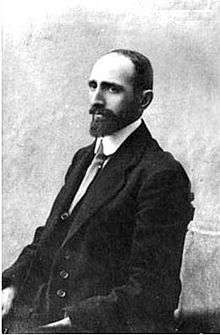
On February 14, 1919, Georgia held parliamentary elections won by the Social Democratic Party of Georgia with 81.5% of the vote. On March 21, Noe Zhordania formed the third government, which had to deal with armed peasants' revolts incited by local Bolshevik activists and largely supported from Russia. These became more troublesome when carried out by ethnic minorities such as Abkhazians and Ossetians.
However, the land reform was finally well handled by the Georgian Social Democratic Party government and the country established a multi-party system in sharp contrast with the "dictatorship of the proletariat" established by the Bolsheviks in Russia. In 1919, reforms in judicial system and local self-governance were carried out. Abkhazia was granted autonomy. Nevertheless, ethnic issues continued to trouble the country, especially on the part of the Ossetians, as witnessed in May 1920. Some contemporaries also observed increasing nationalism among the Social Democratic Party of Georgia leaders.
The year 1920 was marked by increased threats from the Russian SFSR. With the defeat of the White movement and the Red Armies' advance to the Caucasus frontiers, the republic's situation became extremely tense. In January, the Soviet leadership offered Georgia, Armenia and Azerbaijan an alliance against the White armies in South Russia and the Caucasus. The Government of the DRG refused to enter any military alliance, referring to its policy of neutrality and noninterference, but suggested negotiations towards a political settlement of the relations between two countries in the hope that this might lead to recognition of Georgia's independence by Moscow. Severe criticism of the Georgian refusal by Russian leaders was followed by several attempts by local communists to organize mass anti-government protests, which ended unsuccessfully.

In April 1920, the 11th Red Army established a Soviet regime in Azerbaijan, and the Georgian Bolshevik Grigoriy Ordzhonikidze requested permission from Moscow to advance into Georgia. Though official consent was not granted by Lenin and Sovnarkom, local Bolsheviks attempted to seize the Military School of Tbilisi as a preliminary to a coup d'état on May 3, 1920, but were successfully repelled by General Kvinitadze. The Georgian government began mobilization and appointed Giorgi Kvinitadze commander-in-chief. In the meantime, in response to Georgia's alleged provision of assistance to the Azeri nationalist rebellion in Ganja, Soviet forces attempted to penetrate Georgian territory, but were repelled by Kvinitadze in brief border clashes at the Red Bridge. Within a few days, peace talks resumed in Moscow. Under the terms of the controversial Moscow Peace Treaty of May 7, Georgian independence was recognized in return for the legalization of Bolshevik organizations and a commitment not to allow foreign troops on Georgian soil.
Refused entry into the League of Nations on December 16, 1920, Georgia gained de jure recognition from the Allies on 27 January 1921. This, however, did not prevent the country from being attacked by Soviet Russia one month later.
After Azerbaijan and Armenia had been Sovietized by the Red Army, Georgia found itself surrounded by hostile Soviet republics. Moreover, as the British had already evacuated the Caucasus, the country was left without any foreign support.
According to Soviet sources, relations with Georgia deteriorated over alleged violations of the peace treaty, re-arrests of Georgian Bolsheviks, obstruction of convoys passing through Georgia to Armenia, and a strong suspicion that Georgia was aiding armed rebels in the North Caucasus. For its part, Georgia accused Moscow of fomenting anti-government riots in various regions of the country, and of provoking border incidents in the Zaqatala region, disputed with the Azerbaijan Democratic Republic. The Lori “neutral zone” was another challenge, as Soviet Armenia categorically demanded that Georgia withdraw the troops that had been stationed in the region since the fall of the Armenian Republic.
Government and law
The Act of Independence of Georgia, declared on May 26, 1918, in brief, outlined the main principles of the nation's future democracy. According to this act, “the Democratic Republic of Georgia equally guarantees to every citizen within her limits political rights irrespective of nationality, creed, social rank or sex". The first government, formed the same day, was led by Noe Ramishvili. In October 1918, the National Council of Georgia was renamed the Parliament, and announced new elections to be held on February 14, 1919.
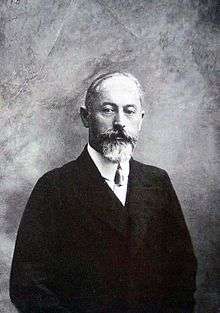
During its two-year history (1919–1921), the newly elected Constituent Assembly of Georgia - Nikolay Chkheidze was the president - adopted 126 laws, specifically, laws on citizenship, local elections, defence, the official language, agriculture, the legal system, political and administrative arrangements for ethnic minorities (including an act about the People's Council of Abkhazia), a national system of public education, and some other laws and regulations on fiscal and monetary policy, railways, and trade and domestic production. On February 21, 1921, facing the onset of Soviet aggression, the Constituent Assembly adopted a constitution of the Democratic Republic of Georgia, the first modern fundamental law in the nation's history.
The chairman of the government was the chief executive post, approved by the parliament for one-year terms of office (the post could not be held for more than two consecutive terms). The chairman appointed ministers, and was responsible for governing the country and representing Georgia in foreign relations. The 1919 government of Georgia adopted a law on jury trials. The right to trial by jury was later incorporated into the Constitution of Democratic Republic of Georgia of 1921.
International Recognition
Under the terms of the Moscow Peace Treaty of May 7, Georgian independence was recognized by Soviet Russia in return for the legalization of Bolshevik organizations and a commitment not to allow foreign troops on Georgian soil.
The independence of the Democratic Republic of Georgia was de jure recognized by Romania, Argentina, Germany, Turkey, Belgium, United Kingdom, France, Japan, Italy, Poland, Czechoslovakia, and Estonia among other countries.
The Government of the Democratic Republic of Georgia in Exile continued to be recognized by many European states as the only legal government of Georgia for some time after 1921. The Government of the Democratic Republic of Georgia in Exile lasted until 1954 continuing to oppose Soviet rule in Georgia.
Political geography
.svg.png)
Georgia's 1918–1921 borders were formed through the border conflicts with its neighbors and ensuing treaties and conventions.
In the north, Georgia was bordered by various Russian Civil War polities until Bolshevik power was established in the North Caucasus in the spring of 1920. The international border between Soviet Russia and Georgia was regulated by the 1920 Moscow Treaty. During the Sochi conflict with the Russian White movement, Georgia briefly controlled the Sochi district in 1918.
In the southwest, the DRG's border with the Ottoman Empire changed with the course of World War I and was modified after the Ottoman defeat in the hostilities. Georgia regained control over Artvin, Ardahan, part of Batum province, Akhaltsikhe and Akhalkalaki. Batum was finally incorporated into the republic after the British evacuated the area in 1920. The Treaty of Sèvres of 1920 granted Georgia control over eastern Lazistan including Rize and Hopa. However, the Georgian government, unwilling to become embroiled in a new war with Turkish Revolutionaries, took no steps to take control of these areas.
The Georgian-Armenian War 1918|Border disputes]] with the First Republic of Armenia over a part of Borchalo district led to a brief war between the two countries in December 1918. With the British intervention the Lori "neutral zone" was created, only to be reoccupied by Georgia after the fall of the Armenian Republic at the end of 1920.
In the southeast, Georgia was bordered by Azerbaijan, which claimed control of Zaqatala district. The dispute, however, never led to hostilities and relations between the two countries were generally peaceful until the Sovietization of Azerbaijan.
The 1919 projects and the 1921 constitution of Georgia granted Abkhazia, Ajaria and Zaqatala a degree of autonomy.
The territory of the Democratic Republic of Georgia included some territories that today belong to other countries. It was circa 107,600 km², compared to 69,700 km² in modern Georgia. The Soviet occupation of the DRG led to significant territorial rearrangements by which Georgia lost almost a third of its territory. Artvin, Ardahan and part of Batumi provinces were ceded to Turkey, Armenia gained control of Lori, and Azerbaijan obtained Zaqatala district. A portion of the Georgian marches along the Greater Caucasus Mountains was taken by Russia.
Armed forces
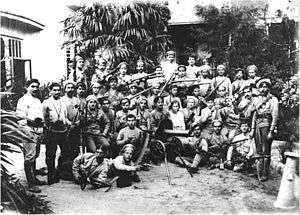
The People's Guard was the privileged military force in the country. Founded on September 5, 1917 as the Worker's Guard, it was later renamed the Red Guard, and finally the People's Guard. It was a highly politicized military structure placed directly under the control of parliament rather than the Ministry of War. Throughout its existence (1917–1921), the Guard was under the command of the Menshevik activist Valiko Jugheli.[7]
The DRG also formed its own regular army. Only part of it was armed in peacetime, the majority being on furlough and following their callings. If the republic had been in danger, they would have been called up by the General Staff, supplied with arms, and allotted to their places. General Giorgi Kvinitadze[8] was commander-in-chief, two times.
From March 1919 to October 1920, the Georgian army was reorganized. It consisted of 3 infantry divisions (later coalesced into one), 2 fortress regiments, 3 artillery brigades, a sapper battalion, a telegraph platoon, a motor squadron with an armored car detachment, a cavalry regiment, and a military school. A People’s Guard consisted of 4 regular battalions. It could further mobilize 18 battalions, i.e., one division. Thus, in 1920, the Georgian army and People’s Guard together comprised 16 infantry battalions (1 army division and a NG regiment), 1 sapper battalion, 5 field artillery divisions, 2 cavalry legions, 2 motor squadrons with 2 armored car detachments, an air detachment and 4 armored trains. Beyond staff and fortress regiments, the army totaled 27,000. Mobilization could increase this number to 87,000. The Georgian navy possessed 1 destroyer, 4 fighter aircraft, 4 torpedo boats, and 10 steamboats.[9]
Although the republic had access to almost 200,000 veterans of World War I with skilled generals and officers, the government failed to build up an effective defense system, a factor that greatly contributed to its collapse.
Economy
Agriculture was a mainstay of the local economy of Georgia, a typical agrarian country with long wine-making traditions. Land reform well managed by the government—Noe Khomeriki[10] was in charge of this project—contributed to a degree of stability in this field.
The manganese industry at Chiatura was of great importance to European metallurgy, providing about 70% of the world supply of manganese in the early 20th century. Traditionally, Georgia served also as an international transportation corridor through the key Black Sea ports of Batumi and Poti.
However, lack of international recognition and the government's only partially successful policy in the field hindered the economic development of the DRG and the country suffered an economic crisis. Some signs of improvement were observed towards 1920–1921.
Education, science and culture
The most important event in the country's cultural life during this turbulent period was indeed the foundation of a national university in Tbilisi (now known as the Tbilisi State University) (1918), a long-time dream of Georgians thwarted by the Imperial Russian authorities for several decades. Other educational centers included gymnasiums in Tbilisi, Batumi, Kutaisi, Ozurgeti, Poti and Gori, Tbilisi Military School, Gori Pedagogical Seminary, the Pedagogical Seminary for Women, etc. Georgia also had a number of schools for ethnic minorities.
The National Museum of Georgia, theaters in Tbilisi and Kutaisi, the Tbilisi National Opera House, and the National Academy of Art were in the vanguard of cultural life.
The newspapers Sakartvelos Respublika (“Republic of Georgia”), Sakartvelo (“Georgia”), Ertoba (“Unity”), Samshoblo (“Motherland”), Sakhalkho Sakme (“Public Affair”), The Georgian Messenger and The Georgian Mail (both published in English) led the national press.
Legacy

The 1918–1921 independence of Georgia, though short-lived, was of particular importance for the development of national feeling among Georgians, a major factor that made the country one of the most active independent forces within the Soviet Union. Leaders of the national movement of the late 1980s frequently referred to the DRG as a victory in the struggle against the Russian Empire and drew parallels with the contemporary political situation, portraying a somewhat idealized image of the Georgian First Republic.
On April 9, 1991 the independence of Georgia was restored when the Act of the Restoration of State Independence of Georgia was adopted by the Supreme Council of the Republic of Georgia. The national symbols used by the DRG were re-established as those of the newly independent nation and remained in use until 2004. May 26, the day of the establishment of the DRG, is still celebrated as a national holiday — the Independence Day of Georgia.
Footnotes
- ↑ (French) Nicolas Cheidzé.
- ↑ (French) Evguéni Guéguétchkori.
- ↑ (French) Akaki Tchenkéli.
- ↑ (French) Noé Jordania.
- ↑ (French) Noé Ramichvili.
- ↑ Sicker, Martin (2001). The Middle East in the Twentieth Century. Greenwood Publishing Group. p. 120. ISBN 0-275-96893-6.
- ↑ (French) Valiko Djougheli.
- ↑ (French) Guiorgui Kvinitadzé.
- ↑ (Russian) А. Дерябин, Р. Паласиос-Фернандес (2000), Гражданская война в России 1917-1922. Национальные армии. ACT, ISBN 5-237-01084-9.
- ↑ (French) Noe Khomeriki.
See also
- 1920 Gori earthquake
- Aftermath of World War I
- August Uprising
- Azerbaijan Democratic Republic
- First Republic of Armenia
- History of Georgia
- List of Georgian people associated with the Democratic Republic of Georgia
- Transcaucasian Democratic Federative Republic
References
- (Georgian) "Legal Acts of the Democratic Republic of Georgia (1918–1921)", Tbilisi, 1990.
- (French) I. Tseretelli, "Separation de la Transcaucasie et de la Russie et Independence de la Georgie", Paris, Imprimerie Chaix, 1919.
- (Georgian) P. Surguladze, "The international importance of the independence of Georgia", Istanbul, 1918.
- (Georgian) P. Surguladze, "Georgia as the independent country", Istanbul, 1918.
- D. Ghambashidze, "Mineral resources of Georgia and Caucasia. Manganese industry of Georgia", London, 1919.
- K. Salia, "The History of Georgian Nation", Paris, 1983.
- (French) Al. Manvelichvili, "Histoire de la Georgie", Paris, 1951.
- (Russian) Z. Avalishvili, "The Independence of Georgia in the International Politics of 1918-1921", Paris, 1923.
- (German) Karl Kautsky: Georgien. Eine sozialdemokratische Bauernrepublik. Eindrücke und Beobachtungen. Wiener Volksbuchhandlung, Wien 1921.
- K. Kandelaki, "The Georgian Question Before the Free World", Paris, 1951.
- (Georgian) G. Kvinitadze, "My answer", Paris, 1954.
- Jan V. Nanuashvili, "What everyone in the Free World should know about Russia", Vantage Press, New York / Washington / Hollywood, 1973.
- (Georgian) V. Tevzadze, "The memoirs of the Georgian Officer". J. "Iveria", No 32, Paris, 1988.
- (Georgian) N. Matikashvili, M. Kvaliashvili, "Cadets". J. "Iveria", No 32, Paris, 1988.
- (Georgian) O. Janelidze, "From May 26 to February 25", Tbilisi, 1990.
- (Georgian) G. Mazniashvili, "The Memoirs", Batumi, 1990.
- (Georgian) (English) L. Urushadze, "Bolshevism-Menshevism and the Democratic Republic of Georgia (1918–1921)", 2nd edition, Publishing House "Ena da Kultura", Tbilisi, 2005, ISBN 99940-23-56-X.
- (Georgian) (English) R. Tsukhishvili, "The English-Georgian Relations (1918–1921)", Tbilisi, 1995.
External links
| Wikimedia Commons has media related to Democratic Republic of Georgia. |
| Wikisource has the text of a 1921 Collier's Encyclopedia article about Democratic Republic of Georgia. |
- 70 years of Soviet Georgia by George Tarkhan-Mouravi.
- The Awakening of Georgia by David Schaich.
- Some national and ethnic problems in Georgia (1918–1922) by Avtandil Menteshashvili.
- Map of 1918–1921 at Armenica.org.
- Territorial rearrangements in Caucasus, 1920–1921
- "Kartuli Idea — The Georgian Idea" by Dr. Levan Z. Urushadze, 2008, ISBN 99940-0-490-5.
- "Democratic Republic of Georgia (1918–1921) by Dr. Levan Z. Urushadze, 2006, ISBN 99940-0-539-1.
- Georgia by Karl Kautsky, an anti-Bolshevik pamphlet.
- Between Red and White, a pamphlet about Georgia by Leon Trotsky.
- La Ière République de Géorgie.
- La Ière République de Géorgie en exil.
Coordinates: 41°43′N 44°47′E / 41.717°N 44.783°E
.svg.png)
